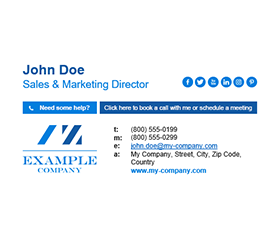
- #SAMPLE PROFESSIONAL SIGNATURE FOR EMAIL HOW TO#
- #SAMPLE PROFESSIONAL SIGNATURE FOR EMAIL FULL#
- #SAMPLE PROFESSIONAL SIGNATURE FOR EMAIL PROFESSIONAL#
Contact informationĮven though the person receiving your message already has your email address, it’s important to include additional methods of communication, such as your direct phone number. You don’t necessarily need to use your current job title (i.e., Account Manager at ABC Company), but it can be helpful to include a title that illustrates what you do.
#SAMPLE PROFESSIONAL SIGNATURE FOR EMAIL FULL#
By using your full name in your email signature, resume, cover letter and any other documents you share, your chances of getting a response should be increased. Use first and last name in your email sign off to avoid confusion and help ensure they remember you.
#SAMPLE PROFESSIONAL SIGNATURE FOR EMAIL PROFESSIONAL#
Thank you for taking the time to review my resume and professional references. For example, a closing line might look like this: The last line of your email should not only share gratitude with the recipient for reading your message but also include a call-to-action or statement that will either motivate the recipient to respond or shows you anticipate a response. There are a few elements you should consider when writing your email closing.
#SAMPLE PROFESSIONAL SIGNATURE FOR EMAIL HOW TO#
Related: How to Email a Resume What to include in your email endings A thoughtful closing will leave a favorable impression on them and makes the communications clear and easy to follow. Additionally, the recipient may forward your email to others within the organization who may not have communicated with you previously. While your conversations might have become more casual, an email closing still exhibits attention to detail and professionalism. In this case, it is good to be thoughtful about including a closing in your email. If you’ve exchanged several emails with someone, it can be tempting to skip the closing.

If you’re unsure, it’s always a good idea to err on the side of professional.ĭecide whether a closing is appropriate.

If you are emailing someone you’ve never met, keep a professional tone by avoiding casual sign-offs like “Chat soon!” If you have exchanged several emails and feel that a more laid-back closing would be more appropriate, feel free to mirror your audience’s tone.

Use context clues to determine the appropriate tone to use in your closing. This way, your recipient is clear on your identity and is less likely to confuse you with other contacts who have the same first name.īe professional. Always include your first and last name in your closing-especially in the first few correspondences. Here are a few things to keep in mind as you compose your email closings: Show Transcript Tips for creating a professional email ending By using friendly, polite and professional language with a clear call-to-action, you have a better chance of earning a positive response. Think of your email closing as the ending of a conversation. “It was so nice meeting you! Please take one of my cards. Instead, you would probably say something like: That would be rude, leave a bad impression and likely prevent future discussions. Once your conversation concluded, you wouldn’t turn and walk away without another word. Imagine meeting a new business contact at an industry event. Related: How to Send an Email Cover Letter Why email closings are importantĪn email closing is the last thing your audience reads after finishing your message and can be the motivating factor in how quickly they respond-or whether they respond at all.

Best practices: Identify your goal, consider your audience, keep it concise, proofread your email, use proper etiquette and remember to follow up.


 0 kommentar(er)
0 kommentar(er)
